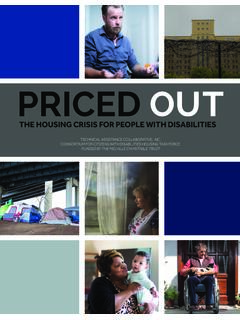Transcription of A Community-Based Comprehensive Psychiatric …
1 A Community-Based Comprehensive Psychiatric crisis Response ServiceAn Informational andInstructional MonographApril 2005 Prepared by the Technical Assistance Collaborative, Inc. A Community-Based Comprehensive Psychiatric crisis Response ServiceAn Informational andInstructional MonographApril 2005 Prepared by the Technical Assistance Collaborative, Inc. Edited By Stephen Day, Executive Director, Technical Assistance Collaborative Pam Hyde, Secretary of the New Mexico Department of Human Services Virginia Mulkern, Principle, Human Services Research Institute John O Brien, Senior Associate, Technical Assistance Collaborative Prepared By Evette Jackson, Associate, Technical Assistance Collaborative Contributors Staff from Baltimore crisis Response, Inc., Baltimore, MD Staff from Washington County Mental Health Services, Inc.
2 , Montpelier, VT Staff from NetCare, ACCESS, Columbus, OH crisis Services Monograph Contents CHAPTER PAGE I. Introduction 1 Why have a Psychiatric crisis system? 1 Purpose of a Psychiatric crisis system 2 crisis services as an integral part of the health care system 3 Information about this Monograph 3II. History of crisis Services 5 Evolution in the location and provision of Psychiatric crisis services 5 Evolution in the purpose of Psychiatric crisis services 7 III. Service Components 8 24-Hour crisis telephone lines 9 Warm lines 9 Walk-in crisis services 9 Mobile crisis outreach 9 crisis respite/residential services 10 Individual residential supports 10 Group residential supports 11 crisis stabilization units 1123-Hour beds 12 Transportation 12IV. Organizational Arrangements and Contracting Issues 13 Funder as sole provider 13 Funder as provider and purchaser 13 Funder as purchaser only 14 Contractor as provider/purchaser 14 Contracting Issues 15V.
3 Roles of crisis Services in the Care Continuum 20 The role of crisis services as a front door to access care 20 The role of crisis services as a back door to access care 21 The role of crisis services as a manager of service resources 22VI. Collaboration and Coordination 23 Outpatient providers 23 Hospital emergency rooms 24 Law enforcement Local police and county jail 24 The courts 26 Primary care physicians and health plans 26 Fire departments Paramedics and 911 27 Social services community information and referral 27 Schools 28 Child-serving agencies 28 VII. crisis Service System Financing 30 Reimbursement options 30 Purchasing capacity versus individual services 31 Expanding the service base 32 Target populations 32 Staffing requirements 33 Sample budget and staffing for crisis service components 33 VIII. Accreditation and Regulatory Requirements 35 Accreditation requirements 35 Regulatory requirements State and federal 36IX.
4 Essential Policies, Procedures, and Protocols 38 Safety 38 Informed consent 38 Psychiatric advanced directives 40 Training 41 Confidentiality and exchange of information 42 Grievances and complaints 43 Continuity and coordination of care 44 Seclusion and restraint 45 Level of care criteria 48 Medications 49 Medical clearance 50X. Data Collection 51 Minimum data set 54XI. A crisis Service System Assessment Checklist 55 Planning 56 Coordination 57 Services 58 Staffing 59 Financing 60 XII. crisis Service Models 61 NetCare ACCESS - Columbus, Ohio 62 Baltimore Mental Health System, Inc. Baltimore, Maryland 68 Washington County Mental Health Services, Inc. - Montpelier, Vermont 73 XIII. Conclusion 80 XIV. Appendices 81 A. American Association of Emergency Psychiatry Standards 81 B. American Association of Suicidology Standards 83 C.
5 Emergency Medical Treatment and Active Labor Law (EMTALA)/COBRA/Anti-Dumping Laws background and summary 90 D. Confidentiality and Exchange of Information Barriers 94 E. Level of Care Criteria for crisis Service Components 98 F. Studies of crisis Service System Components 99 G. Contact List of crisis Service Models Featured in this Report 100 H. Excerpts from the Evaluation of NetCare ACCESS by the ADAMH Board 101 I. crisis Service Models Tables 103 NetCare ACCESS Tables 103 BCRI and B-CARS Tables 106 WCMHS Tables 109 Consolidated Comparative Grids 111 XV. Glossary of Terms 113 XVI. References 119 Introduction 1 Chapter One: Introduction Since publication of the Surgeon General s Report on Mental Illness in 1999, there has been renewed attention and energy focused on improving public mental health systems of care, especially through the implementation of evidence- based practices.
6 Comprehensive crisis response and stabilization services, although not yet deemed an evidence- based practice, have long been considered a crucial element of public mental health systems. There is a considerable body of evidence suggesting that Comprehensive crisis services can improve outcomes for consumers, reduce inpatient hospital stays and costs, and facilitate access to other necessary mental health services and supports. In many communities, crisis response services also perform important public health, public safety, and community well-being functions. f Why Have a Psychiatric crisis System? Prevalence One in every five individuals will experience a mental illness during the course of a Furthermore, a 1997 National Hospital Ambulatory Medical Care Survey indicates that the frequency of mental disorder presentations in outpatient departments ranks only second to diseases of the respiratory Impact The Global Burden of Disease study conducted by the World Health Organization, found that 50 percent of the ten leading causes of disability for persons five years of age and older is due to mental Whether long-term or intermittent, mental illness is sufficiently prevalent in and costly to our communities across the nation that it can no longer be ignored.
7 Therefore, an integrated Psychiatric crisis services response system that is coordinated with a range of supportive and social services is necessary to meet the community s needs. 1 National Association of Psychiatric Health Systems. (2000). Fact sheet: Behavioral health is an integral part of overall health. Retrieved from website: 2 National Center for Health Statistics. (1997). National Hospital Ambulatory Medical Care Survey. Retrieved from website: 3 Murray, C. J. L., Lopez, A. D. (1996). The Global Burden of Disease. Cambridge, MA: Harvard School of Public Health. Chapter One 2 f Purpose of a Psychiatric crisis System For persons experiencing Psychiatric crises, a competent crisis response service system should be able to: Provide timely and accessible aid; Provide access to a wide range of crisis stabilization options; Stabilize them as quickly as possible and assist them to return to their pre- crisis level of functioning; Increase and maintain their community tenure; Increase their ability to recognize and deal with situations that may otherwise result in crises; and Increase or improve their network of community and natural supports, as well as their use of these supports for crisis prevention.
8 In order to fulfill the operational capabilities listed above, a crisis response system must be able to: Resolve crises for persons with serious mental illness, 24 hours a day, seven days a week; Recruit and retain appropriately skilled and trained, linguistically and culturally competent staff that are capable of serving adults, children, adolescents, and families; Serve as a community resource for crisis response, stabilization, and referral of individuals, including children and adolescents, who are in crisis ; Provide appropriate linkages and arrangements that alleviate the use of law enforcement as the primary responder to individuals in crisis , thus, minimizing the criminalization of persons with mental illness; Provide services that are adequate for individuals with multiple service needs, specifically individuals with co-occurring disorders and/or accompanying medical conditions; Provide a range of crisis services that divert people from inpatient Psychiatric hospitalization, emergency rooms to less costly service alternatives; Directly transport and/or arrange for the transport of individuals in crisis for treatment; Establish links with healthcare resources to provide and/or arrange for medical clearance, toxicology screens, and lab work, as well as medical and non-medical detoxification services; Coordinate with the consumer s primary behavioral health provider for follow-up and post- crisis care.
9 And Incorporate evaluation protocols to measure the effectiveness of the crisis services. Introduction 3 Examples of crisis program components might include: Telephone crisis services staffed by skilled professionals to assess, make appropriate referrals, and dispatch mobile teams; S Mobile crisis units with the ability to respond within one hour to a Psychiatric crisis in the community ( , homes, schools, or hospital emergency rooms); + A range of short-term crisis residential services ( , supervised apartments/houses, foster homes, and crisis stabilization services); and 3 Urgent care services with the capacity for immediate clinical intervention, triage, and stabilization. f crisis Services as an Integral Part of the Health Care System There is growing recognition that Psychiatric crisis services cannot and do not operate on the fringe of the health care system, but rather are mainstream activities necessary to complete the health care continuum.
10 crisis services cut across many different systems, including: Social services: Housing, medical benefits, child welfare, etc.; Legal: Involuntary confinement or detainment for the purpose of treatment and evaluation; Health: Medical services; and community and personal safety: Law enforcement assessment of danger to self or the community . Due to this multi-system involvement in delivering crisis services, a psychosocial rehabilitation framework is promoted through the application of a systems approach to crisis service intervention. Such an approach ensures that no aspect of the life of the individual with mental illness is ignored or denied the necessary assessment or f Information about this Monograph This document is intended to be used as a tool by any individual or group who is considering developing a new crisis service delivery system, expanding an existing crisis service system, or improving the effectiveness of an existing system.










